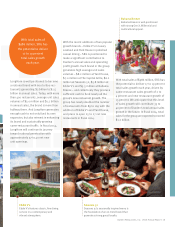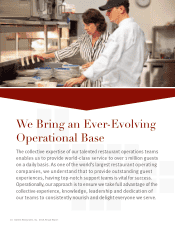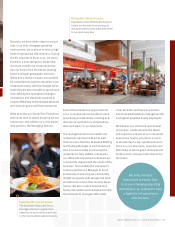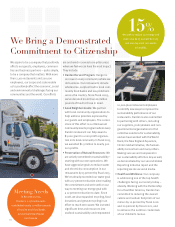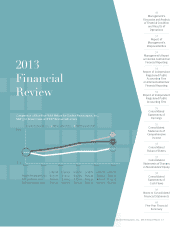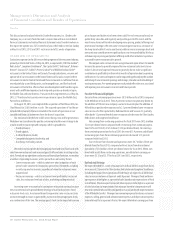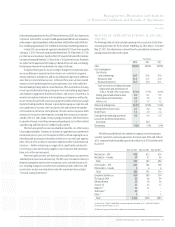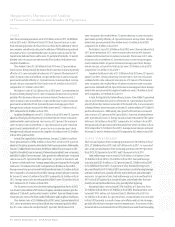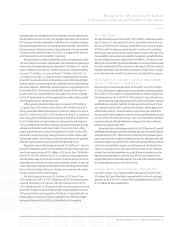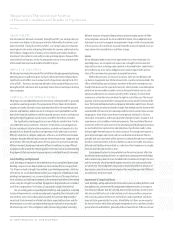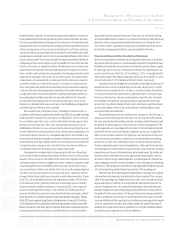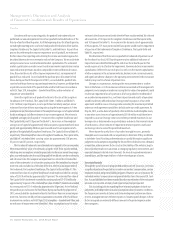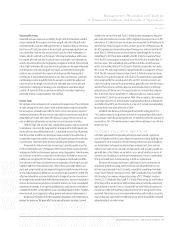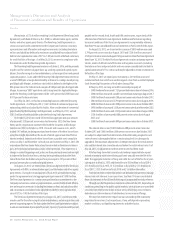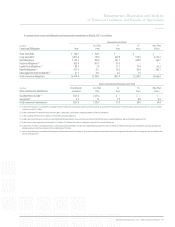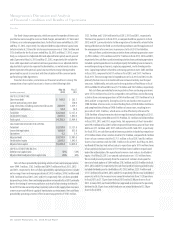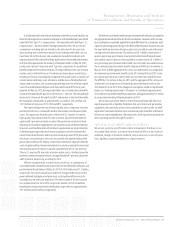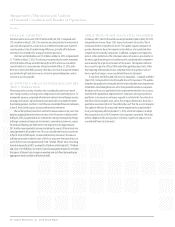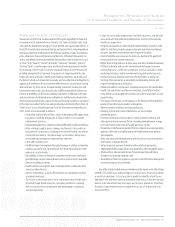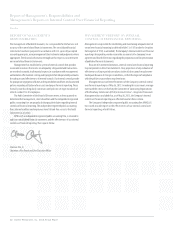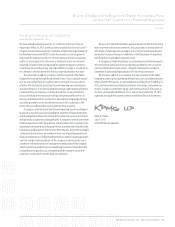Red Lobster 2013 Annual Report Download - page 27
Download and view the complete annual report
Please find page 27 of the 2013 Red Lobster annual report below. You can navigate through the pages in the report by either clicking on the pages listed below, or by using the keyword search tool below to find specific information within the annual report.
Management’s Discussion and Analysis
of Financial Condition and Results of Operations
Darden
Darden Restaurants, Inc. 2013 Annual Report 23
determined to be impaired, the amount of impairment recognized is measured
by the amount by which the carrying amount of the assets exceeds their fair value.
Fair value is generally determined by appraisals or sales prices of comparable assets.
Restaurant sites and certain other assets to be disposed of are reported at the lower
of their carrying amount or fair value, less estimated costs to sell. Restaurant sites
and certain other assets to be disposed of are included in assets held for sale within
prepaid expenses and other current assets in our consolidated balance sheets when
certain criteria are met. These criteria include the requirement that the likelihood
of disposing of these assets within one year is probable. For assets that meet the
held-for-sale criteria, we separately evaluate whether those assets also meet the
requirements to be reported as discontinued operations. Principally, if we discon-
tinue cash flows and no longer have any significant continuing involvement with
respect to the operations of the assets, we classify the assets and related results
of operations as discontinued. We consider guest transfer (an increase in guests
at another location as a result of the closure of a location) as continuing cash
flows and evaluate the significance of expected guest transfer when evaluating
a restaurant for discontinued operations reporting. To the extent we dispose of
enough assets where classification between continuing operations and discon-
tinued operations would be material to our consolidated financial statements,
we utilize the reporting provisions for discontinued operations. Assets whose
disposal is not probable within one year remain in land, buildings and equipment
until their disposal within one year is probable.
We account for exit or disposal activities, including restaurant closures, in
accordance with Financial Accounting Standards Board (FASB) Accounting Standards
Codification (ASC) Topic 420, Exit or Disposal Cost Obligations. Such costs include
the cost of disposing of the assets as well as other facility-related expenses from
previously closed restaurants. These costs are generally expensed as incurred.
Additionally, at the date we cease using a property under an operating lease, we
record a liability for the net present value of any remaining lease obligations, net
of estimated sublease income. Any subsequent adjustments to that liability as a
result of lease termination or changes in estimates of sublease income are recorded
in the period incurred. Upon disposal of the assets, primarily land, associated with
a closed restaurant, any gain or loss is recorded in the same caption within our
consolidated statements of earnings as the original impairment.
The judgments we make related to the expected useful lives of long-lived
assets and our ability to realize undiscounted cash flows in excess of the carrying
amounts of these assets are affected by factors such as the ongoing maintenance
and improvements of the assets, changes in economic conditions, changes in usage
or operating performance, desirability of the restaurant sites and other factors,
such as our ability to sell our assets held for sale. As we assess the ongoing expected
cash flows and carrying amounts of our long-lived assets, significant adverse
changes in these factors could cause us to realize a material impairment loss. During
fiscal 2013, we recognized long-lived asset impairment charges of $0.8 million
($0.5 million net of tax), primarily related to the write-down of assets held for
disposition based on updated valuations. During fiscal 2012, we recognized
long-lived asset impairment charges of $0.5 million ($0.3 million net of tax),
primarily related to the permanent closure of one Red Lobster restaurant, and the
write-down of assets held for disposition based on updated valuations. During
fiscal 2011 we recognized long-lived asset impairment charges of $4.7 million
($2.9 million net of tax), primarily related to the permanent closure of two Red
Lobster restaurants, the write-down of another Red Lobster restaurant based on
an evaluation of expected cash flows, and the write-down of assets held for
disposition based on updated valuations. These costs are included in selling,
general and administrative expenses as a component of earnings from continuing
operations in the accompanying consolidated statements of earnings for fiscal
2013, 2012 and 2011. Impairment charges were measured based on the amount
by which the carrying amount of these assets exceeded their fair value.
Valuation and Recoverability of Goodwill and Trademarks
We review our goodwill and trademarks for impairment annually, as of the first
day of our fiscal fourth quarter, or more frequently if indicators of impairment exist.
Goodwill and trademarks are not subject to amortization and have been assigned
to reporting units for purposes of impairment testing. The reporting units are
our restaurant brands. At May 26, 2013 and May 27, 2012, we had goodwill of
$908.3 million and $538.6 million, respectively. At May 26, 2013 and May 27, 2012,
we had trademarks of $573.8 million and $464.9 million, respectively.
A significant amount of judgment is involved in determining if an indicator of
impairment has occurred. Such indicators may include, among others: a signifi-
cantdeclineinourexpectedfuturecashflows;asustained,significantdeclinein
ourstockpriceandmarketcapitalization;asignificantadversechangeinlegal
factorsorinthebusinessclimate;unanticipatedcompetition;thetestingfor
recoverabilityofasignificantassetgroupwithinareportingunit;andslower
growth rates. Any adverse change in these factors could have a significant impact
on the recoverability of these assets and could have a material impact on our
consolidated financial statements.
The goodwill impairment test involves a two-step process. The first step is a
comparison of each reporting unit’s fair value to its carrying value. We estimate
fair value using the best information available, including market information and
discounted cash flow projections (also referred to as the income approach). The
income approach uses a reporting unit’s projection of estimated operating results
and cash flows that is discounted using a weighted-average cost of capital that
reflects current market conditions. The projection uses management’s best esti-
mates of economic and market conditions over the projected period including
growth rates in sales, costs and number of units, estimates of future expected
changes in operating margins and cash expenditures. Other significant estimates
and assumptions include terminal value growth rates, future estimates of capital
expenditures and changes in future working capital requirements. We validate our
estimates of fair value under the income approach by comparing the values to
fair value estimates using a market approach. A market approach estimates fair
value by applying cash flow and sales multiples to the reporting unit’s operating
performance. The multiples are derived from comparable publicly traded companies
with similar operating and investment characteristics of the reporting units.
If the fair value of the reporting unit is higher than its carrying value, goodwill
is deemed not to be impaired, and no further testing is required. If the carrying
value of the reporting unit is higher than its fair value, there is an indication that
impairment may exist and the second step must be performed to measure the
amount of impairment loss. The amount of impairment is determined by com-
paring the implied fair value of reporting unit goodwill to the carrying value of
the goodwill in the same manner as if the reporting unit was being acquired in a
business combination. Specifically, we would allocate the fair value to all of the
assets and liabilities of the reporting unit, including any unrecognized intangible
assets, in a hypothetical analysis that would calculate the implied fair value of
goodwill. If the implied fair value of goodwill is less than the recorded goodwill,
we would record an impairment loss for the difference.


